The F-86 Sabre has been on my mind lately. The Sabre was a pure air-to-air jet fighter with a high-mounted seat and 360-degree visibility, father of the F-15 Eagle, grandfather of the F-22 Raptor.
As a boy living at Ramstein Air Base in Germany in the 1950s, I dreamed of someday flying the Sabres I saw flying overhead. Today I’m a volunteer docent at the Pima Air & Space Museum in Tucson, which has four F-86s and one FJ-4 naval variant in its collection. I’ve always loved these clean, purposeful fighters, and when the museum recently set up a Korean War display with a USAF F-86 and a North Korean MiG-15, I was asked to write a fact sheet on the MiG Alley aerial battles between the Sabres and the MiGs.
During my MiG Alley research I came across references to the Gun-Val Project, where heavier guns were installed in test F-86s and evaluated in combat against the MiG. A big problem emerged during the Gun-Val tests, a problem eventually overcome by a miniature horseshoe.
The F-86’s air-to-air armament was a set of six .50 caliber machine guns, mounted three per side and firing through gun ports on the nose. USAF pilots in Korea complained that the Sabre’s punch was too light. They were scoring multiple hits on MiGs — and had the gun camera film to prove it — but all too often the MiGs survived to fight another day. They wanted the Sabre modified to pack a heavier punch, and this was the origin of the Gun-Val Project.
A few production F-86F Sabres were modified to carry a set of four 20 mm cannon, mounted two per side and firing, as before, through gun ports on the nose. The aircraft were initially tested in the USA, where they performed well, then sent to Korea to be put to the true test: air-to-air combat against the MiG-15.
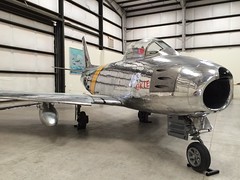 |
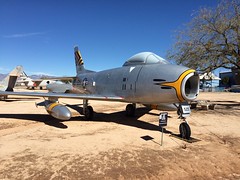 |
Although Gun-Val was ultimately judged a success, these test aircraft were the only ones armed with 20 mm cannon during the Korean War. After the war new versions of the F-86 — the F-86H, the final production model of the Sabre, along with a naval variant, the FJ-4 Fury — were finally armed with the 20 mm cannon. Older Sabres were never retrofitted, and continued to fly with the six .50 caliber machine guns. In the photos above you can see a Korean War-era F-86E with six .50 caliber machine guns next to a post-Korean War F-86H with four 20 mm cannon.
Preliminary Gun-Val results in the USA were good, but test firings had been conducted below 30,000 feet. When Gun-Val aircraft began flying combat in Korea, where air-to-air battles frequently happened above 30,000 feet, pilots began to experience flameouts when they fired the cannon. The cannon, which fired at the rate of 1,500 rounds per minute, generated a thick cloud of gas in front of the Sabre’s air intake. When the gas was sucked into the engine it caused compressor stalls and flameouts in the thinner air at high altitude. One of the test aircraft was actually lost when its pilot couldn’t get the engine restarted and had to eject over the Yellow Sea.
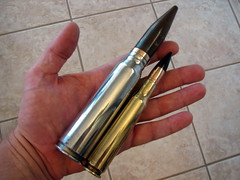 |
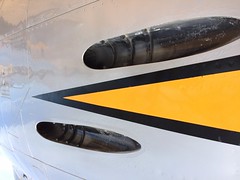 |
The gas ingestion problem was eventually solved by welding small horseshoe-shaped deflectors into the gun troughs. The deflectors forced the gas off to the side, without interfering with the path of the rounds being fired. You can see the deflectors in one of the photos above, along with a graphic depiction of the relative sizes of 20 mm and .50 caliber rounds.
The horseshoe deflectors saved the program, and Gun-Val was a success. The horseshoes found their way into production aircraft — the ones in the photo are on the museum’s F-86H. Immediately below are photos of a post-Korean War variant of the F-86, the US Navy’s FJ-4B Fury, also armed with four 20 mm cannon, and a detail shot with a clearer view of the horseshoes.
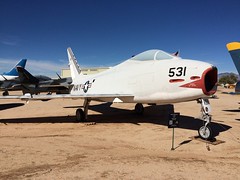 |
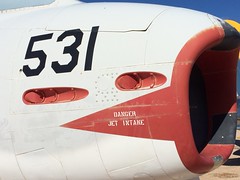 |
Finally, here’s a USAF video (no sound) of Gun-Val tests in Korea. It contains footage of gun gas being generated in front of the nose of a test F-86, along with gun camera film of engagements with MiG-15s, and some gunnery range film of air-to-ground strafing tests.
Two versions of the 20 mm cannon were evaluated during the Gun-Val tests: a WWII German Mauser design re-engineered by the Ford Motor Company and called the T-160, and a Swiss-designed Oerlikon cannon from the same era. The Swiss cannon proved unreliable and were quickly abandoned. The T-160 was a gas operated, electrically fired, belt fed, revolving cylinder gun with a cyclic rate of 1400-1500 rounds per minute, each cannon supplied by a belt containing 100-150 20 mm rounds, depending on the production model and installation. On the F-86, all four cannon fired at once. Total firing time was, at most, about six seconds.
As noted, after the Gun-Val tests the T-160 was adopted for the post-Korean War F-86H Sabre and FJ-4 Fury. By then it had been re-designated the M39 cannon, and was later used on the F-100 Super Sabre, the F-101 Voodoo, and the F-5 Freedom Fighter (many of which are still flying today).
Today the standard USAF 20 mm cannon is the M61A1 Vulcan, a six-barrel Gatling-style rotary cannon which fires at the rate of 6,000 rounds per minute. It was first used on Vietnam-era F-105 and F-4 fighters, later by some versions of the F-106 and F-111, and still in use today on the F-14*, F-15, F-16, F-18, and F-22.
References:
- Project Val: Combat Testing the Cannon-Armed Sabre
- Cannon-Armed F-86Fs
- Wikipedia: T-160/M39 Cannon
- Wikipedia: M61A1 Vulcan
* Yes, all US Navy F-14s have been retired, but a few are still flying with the Islamic Republic of Iran’s air force.